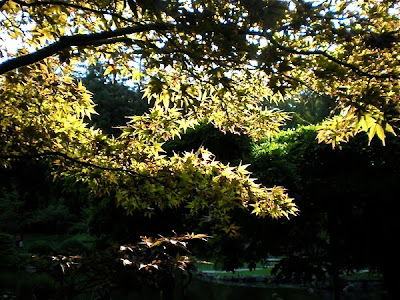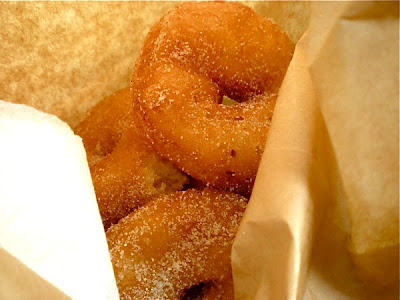
I paid my first visit to Seattle- and to the Pacific Northwest, actually- a few months ago. The delay in writing about it is all due to fault with me, and none with the place itself.
The food was outstanding- I'd never seen so many vegetables, fruits, cheeses, grains all in season at the same time- tea was plentiful (although I did pack some to take with me, just in case), the weather was gorgeous, and the light, everywhere, was marvelous. My friend who I was visiting agreed when I exclaimed over how subtly different everything, from leaves to water to bricks, was illuminated. Her explanation was that the sky seems closer here.
She was completely right; the clouds seemed tantalizingly within reach, like a pile of meringues behind a pastry case.

Each morning, I'd tiptoe through her kitchen, silently preparing my first cup of tea, and slip outside to a dock steps from her door to watch the sun rise over Lake Washington. Curling around the cup, listening to the waves' hollow lapping under the piers, it seemed to me like nothing else was awake, except a snow-capped Mt. Rainier emerging like a mirage across the water and spiders slowly stretching in their glistening webs. After I finished my tea, on the way back to the apartment, I'd pluck dewy blackberries right off the vine and straight into my mouth, marveling at this world of green and blue well within city limits. And I finally understood how she could leave New York and call this place home for the past four years.
I tried to be diligent about tasting, taking notes and photos of all the other places I had tea over the long weekend, but I really was enjoying it- and eating- too much to stay focused. (Consuming donuts at every meal, three days in a row, didn't help my concentration either.)


So in lieu of a tea-room rundown, I wanted instead to capture the essence of the place, back here in my kitchen. As I somehow managed to stave off diabetes on the trip, I was leaning more toward savory than sweet.

It's been some time since I've made a traditional, slow-rise, knead-for-15-minutes-while-you-space-out-and-revert-to-a-trancelike-prelingual-calm bread. But with those local dried cherries and farro I stuffed into my suitcase (those two pounds of kippered salmon I carried back in my purse were consumed long ago), it was clear what to do.

Baking is a ritual that both comforts and commemorates- one of the most basic, and most satisfying. And so here is whole-wheat farro bread: how I remember Seattle.
Whole-Wheat Farro Bread
Makes: 2 loaves.
1 cup farro
1 tablespoon kosher salt
4 tablespoons olive oil
4 tablespoons plus 1 teaspoon molasses
1 cup dried cherries
1 package (scant 1 tablespoon) active dry yeast
1 1/2 cups bread or all-purpose flour
2 cups whole-wheat flour
1 to 2 cups white whole-wheat flour
1. In medium bowl, combine farro and 1 cup boiling water. Cover and let sit 30 minutes, then stir in salt, olive oil, 4 tablespoons molasses and dried cherries. Cover and let stand an additional 30 minutes.
2. In large bowl, dissolve yeast in 1 cup warm water. Stir in 1 teaspoon molasses, then mix in 1 1/2 cups bread flour. Cover with a damp cloth, set in a warm place, and let rise 30 to 45 minutes.
3. With a wooden spoon, beat farro mixture into risen dough until completely incorporated. Gradually stir in 2 cups whole-wheat flour and 1 cup white whole-wheat flour into the dough, adding more flour as necessary and turning dough out onto a lightly floured surface once it becomes too stiff to stir. Knead for 15 minutes, adding flour only if sticky, until dough is smooth and supple. Lightly oil large bowl and turn dough in it to coat. Cover with a damp cloth and set in a warm place to rise until doubled in bulk, about 1 to 1 1/2 hours.
4. Punch dough down and knead lightly for a few minutes. Divide in half, and shape into a free-form boule or pat into an oval, and place in an oiled loaf pan. Cover each with a damp cloth and let rise until doubled, about 45 minutes.
5. Heat oven (and pizza stone, if you have one) to 400°. Bake boule directly on stone or baking sheet, or loaf in pan, for about 45 minutes. Let cool on rack, turning bread out of pan (if using) after 10 minutes. Cool completely before slicing.
Makes: 2 loaves.
1 cup farro
1 tablespoon kosher salt
4 tablespoons olive oil
4 tablespoons plus 1 teaspoon molasses
1 cup dried cherries
1 package (scant 1 tablespoon) active dry yeast
1 1/2 cups bread or all-purpose flour
2 cups whole-wheat flour
1 to 2 cups white whole-wheat flour
1. In medium bowl, combine farro and 1 cup boiling water. Cover and let sit 30 minutes, then stir in salt, olive oil, 4 tablespoons molasses and dried cherries. Cover and let stand an additional 30 minutes.
2. In large bowl, dissolve yeast in 1 cup warm water. Stir in 1 teaspoon molasses, then mix in 1 1/2 cups bread flour. Cover with a damp cloth, set in a warm place, and let rise 30 to 45 minutes.
3. With a wooden spoon, beat farro mixture into risen dough until completely incorporated. Gradually stir in 2 cups whole-wheat flour and 1 cup white whole-wheat flour into the dough, adding more flour as necessary and turning dough out onto a lightly floured surface once it becomes too stiff to stir. Knead for 15 minutes, adding flour only if sticky, until dough is smooth and supple. Lightly oil large bowl and turn dough in it to coat. Cover with a damp cloth and set in a warm place to rise until doubled in bulk, about 1 to 1 1/2 hours.
4. Punch dough down and knead lightly for a few minutes. Divide in half, and shape into a free-form boule or pat into an oval, and place in an oiled loaf pan. Cover each with a damp cloth and let rise until doubled, about 45 minutes.
5. Heat oven (and pizza stone, if you have one) to 400°. Bake boule directly on stone or baking sheet, or loaf in pan, for about 45 minutes. Let cool on rack, turning bread out of pan (if using) after 10 minutes. Cool completely before slicing.

This bread is slightly sweet, from the molasses and cherries, but it's balanced out by the whole-wheatiness and chewy, nutty bites of farro. And while it is delightful all on its own, a toasted slice with butter or melted cheese along with your afternoon cup of tea is heavenly.

If you can't find farro, another grain like bulgur, brown rice or oats- or even chopped walnuts- would be an excellent stand-in. Or you can just plan a trip to Seattle to get some.

For more gluteny goodness, check out YeastSpotting.















































